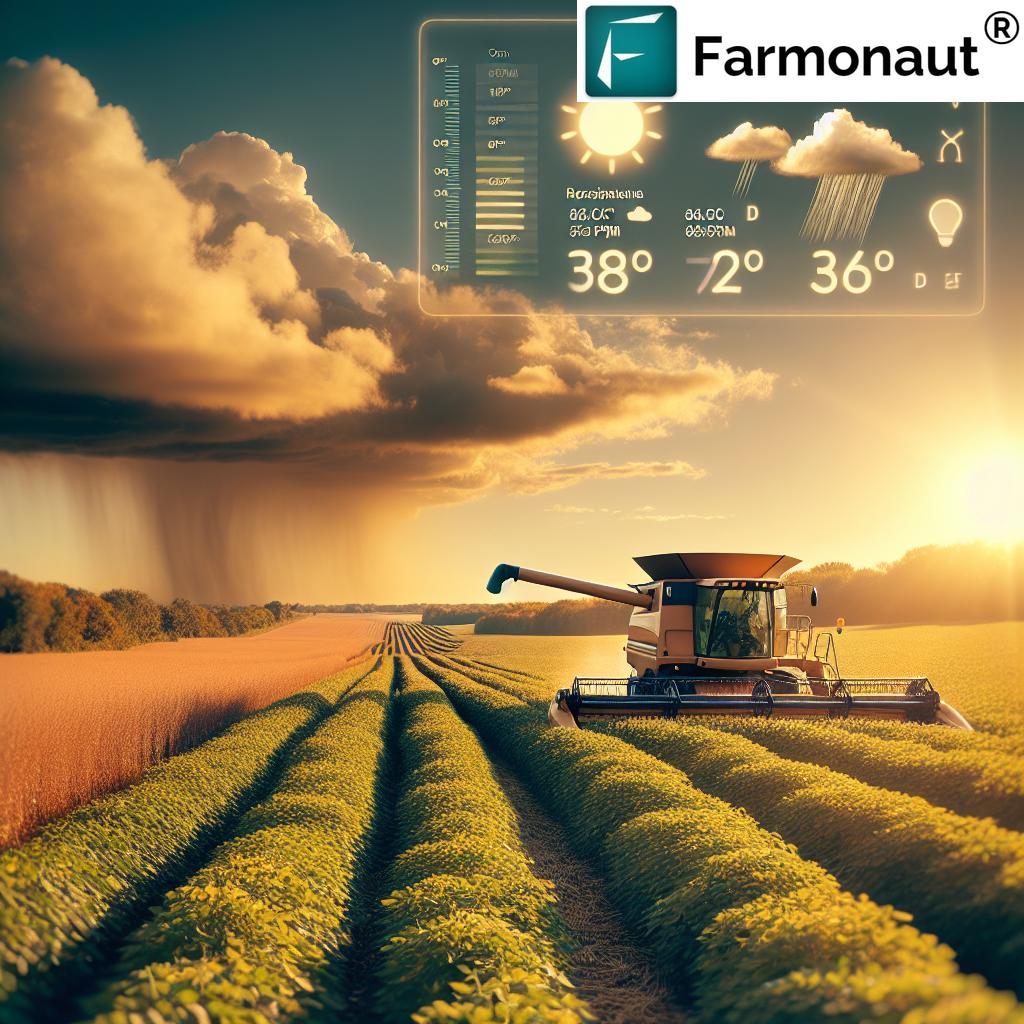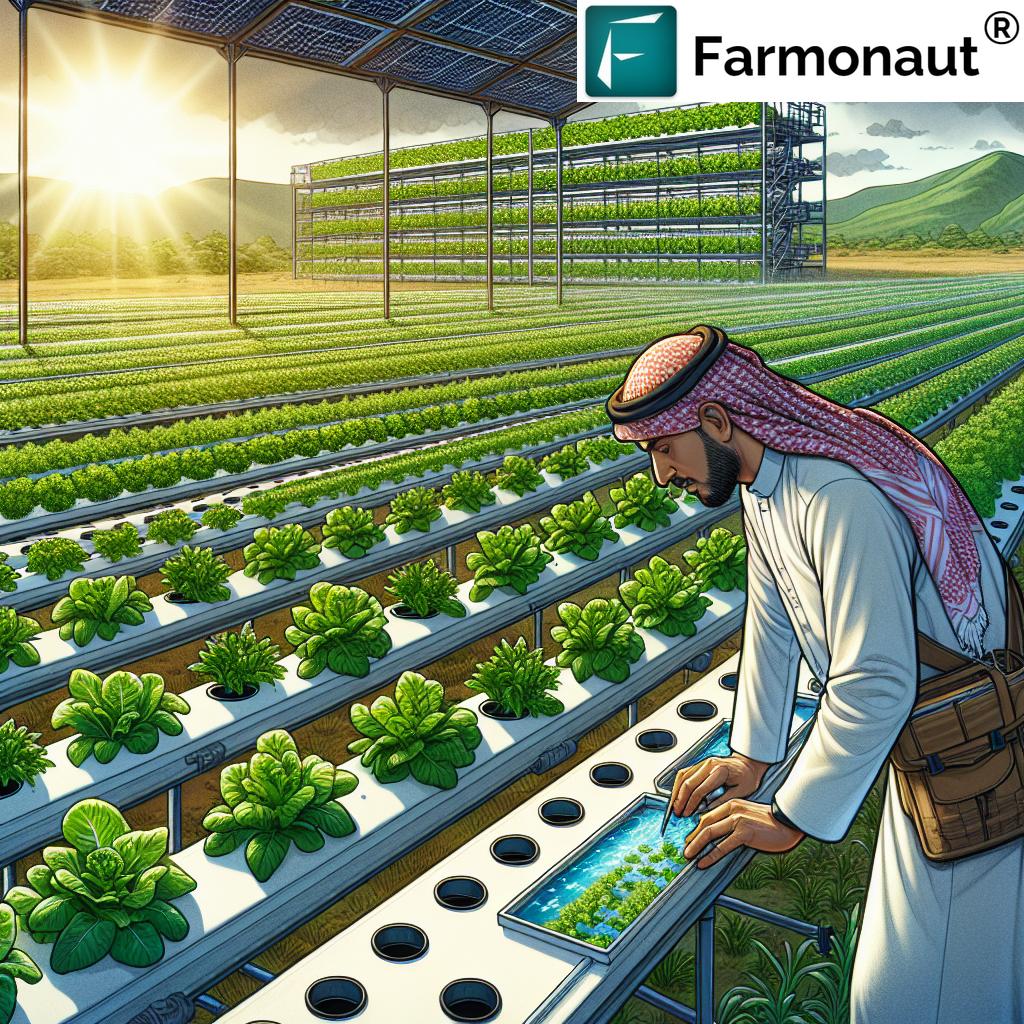October Forecast: Warm Weather and Rain Boost Midwest Crop Yield Prospects for Farmers
“October 28, 2024 forecast predicts warmer temperatures and increased rainfall for Midwest states, potentially boosting crop yields by 15-20%.”
Welcome, farmers and agricultural stakeholders! We’re excited to bring you the latest weather forecast for farmers, particularly those in the Midwest states of Iowa, Illinois, and Missouri. As we approach October 28, 2024, a shift in agricultural weather patterns promises to bring warmth and moisture to our farms, potentially revolutionizing our crop yield optimization strategies and soil moisture management techniques.
In this comprehensive guide, we’ll explore how these changing weather conditions can impact your farming operations, from soybean farming best practices to maximizing farm profits. We’ll also delve into how precision agriculture techniques, particularly those offered by Farmonaut, can help you leverage these weather patterns effectively.
The Forecast: Warm Weather and Rain on the Horizon
Let’s start by breaking down the weather forecast for October 28, 2024:
- Temperature: A significant warm-up is expected across the Midwest, with temperatures rising above average for this time of year.
- Precipitation: Much-needed rain is forecasted, bringing relief to areas that have been experiencing drier conditions.
- Wind: Light to moderate winds are expected, which should help in the even distribution of rainfall.
This combination of warmth and moisture is particularly beneficial for late-season crops, especially soybeans, which are still in their critical development stages in many parts of the Midwest.

Impact on Midwest States: Iowa, Illinois, and Missouri
The forecasted weather conditions are expected to have a significant positive impact on the agricultural sectors of Iowa, Illinois, and Missouri. Let’s break down the potential effects for each state:
Iowa
- As the leading producer of corn and soybeans in the United States, Iowa stands to benefit greatly from this weather pattern.
- The warm temperatures will help accelerate crop maturity, particularly for late-planted fields.
- The expected rainfall will replenish soil moisture, which is crucial for the final stages of soybean development.
Illinois
- Illinois, another major producer of corn and soybeans, will likely see improved crop conditions with this forecast.
- The warmer weather will be particularly beneficial for the southern parts of the state, where crop development has been slightly behind schedule.
- Increased soil moisture will support better pod fill in soybeans, potentially boosting yields.
Missouri
- Missouri’s diverse agricultural landscape, including crops like corn, soybeans, and cotton, will benefit from the warm and wet conditions.
- The rainfall will be especially welcome in areas that have been experiencing drought conditions.
- Improved soil moisture will support pasture growth, benefiting livestock operations across the state.
Now, let’s take a closer look at how these weather conditions can impact specific aspects of farming operations.
Crop Yield Optimization: Leveraging the Forecast
The upcoming warm and moist conditions present an excellent opportunity for crop yield optimization. Here’s how farmers can make the most of this weather pattern:
- Delayed Harvest Considerations: With warmer temperatures, farmers might consider delaying harvest slightly to allow for maximum dry-down in the field, reducing drying costs.
- Nutrient Management: The expected rainfall provides an opportunity for a final round of nutrient application, particularly for winter wheat or cover crops.
- Pest and Disease Monitoring: Warm, moist conditions can also favor the development of certain pests and diseases. Vigilant crop health monitoring will be crucial.
- Soil Preparation: For farmers planning fall tillage or fertilizer application, the improved soil moisture will create ideal conditions for these activities.
To effectively implement these strategies, precision agriculture techniques are invaluable. Farmonaut’s satellite-based crop monitoring system can provide real-time insights into crop health, allowing for targeted interventions where needed.
“Timely precipitation in Iowa, Illinois, and Missouri could increase soybean farming profits by up to $50-$75 per acre.”
Soil Moisture Management: Making the Most of the Rain
Effective soil moisture management is crucial for maximizing the benefits of the forecasted rainfall. Here are some strategies to consider:
- Conservation Tillage: Minimize soil disturbance to retain moisture and reduce evaporation.
- Cover Crops: If not already implemented, consider planting cover crops to improve soil structure and water retention.
- Drainage Systems: Ensure proper functioning of drainage systems to prevent waterlogging in case of heavy rainfall.
- Soil Moisture Monitoring: Utilize precision agriculture tools like Farmonaut’s soil moisture sensors to track moisture levels accurately.
By implementing these practices, farmers can ensure that their fields are in the best possible condition to absorb and retain the incoming moisture, setting the stage for improved crop performance.
Soybean Farming Best Practices for Late-Season Care
For soybean farmers, this weather forecast comes at a critical time. Here are some best practices to optimize your soybean crop in these conditions:
- Harvest Timing: Monitor moisture levels closely. The warm weather may accelerate dry-down, but be cautious of potential re-wetting from rainfall.
- Disease Management: Be vigilant for late-season diseases that thrive in warm, moist conditions. Consider a fungicide application if warranted.
- Lodging Prevention: Strong plant stems are crucial to prevent lodging. Ensure adequate potassium levels in your soil.
- Post-Harvest Planning: Use this time to plan for next season. Consider soil testing to inform your fertilization strategy for the coming year.
Farmonaut’s crop health monitoring tools can be particularly useful in identifying areas of your soybean fields that may need extra attention during this critical period.

Maximizing Farm Profits: Strategic Approaches
The favorable weather conditions present an opportunity to maximize farm profits. Here are some strategies to consider:
- Yield Forecasting: Use precision agriculture tools to estimate yields accurately, helping with marketing decisions.
- Cost Management: The improved growing conditions may reduce the need for certain inputs, potentially lowering costs.
- Quality Premium: Focus on maintaining crop quality to potentially secure premium prices at harvest.
- Risk Management: Consider how these improved conditions might affect your crop insurance strategies.
Farmonaut’s AI-driven advisory system can provide valuable insights to support these profit-maximizing decisions.
Sustainable Farming Methods: Aligning with Weather Patterns
The forecasted weather conditions also provide an excellent opportunity to implement and reinforce sustainable farming methods:
- Water Conservation: While rain is expected, continue to practice efficient water use. Consider implementing precision irrigation systems.
- Soil Health: The moist conditions are ideal for soil-building practices like cover cropping and reduced tillage.
- Integrated Pest Management (IPM): Use the favorable conditions to strengthen plant health naturally, reducing the need for chemical interventions.
- Carbon Sequestration: Healthy, growing crops contribute to carbon sequestration. Consider how your practices can maximize this benefit.
Farmonaut’s platform includes tools for monitoring these sustainable practices, helping farmers quantify their environmental impact.
Agricultural Technology Innovations: Adapting to Changing Conditions
To fully leverage the benefits of this weather forecast, consider incorporating these agricultural technology innovations:
- Satellite Imagery: Use Farmonaut’s satellite-based crop monitoring to track crop development and identify potential issues early.
- Weather Stations: Install on-farm weather stations to get hyper-local weather data for more precise decision-making.
- Soil Sensors: Deploy soil moisture and temperature sensors to optimize irrigation and nutrient management.
- Drones: Consider using drones for detailed crop scouting, especially in larger fields.
These technologies can provide valuable data to support your farming decisions in response to the changing weather conditions.
Impact on Rural Communities
The positive agricultural outlook resulting from this weather forecast extends beyond individual farms to impact entire rural communities:
- Economic Boost: Improved crop yields can lead to increased farm income, which often circulates through local economies.
- Employment Opportunities: A good harvest season may create additional temporary employment in agricultural services and processing.
- Community Well-being: Successful farming seasons often correlate with improved community morale and social cohesion.
- Infrastructure Investment: Increased agricultural productivity may spur investments in rural infrastructure and services.
By leveraging precision agriculture techniques and sustainable farming methods, farmers can contribute not only to their own success but also to the prosperity of their wider communities.
Livestock Considerations
While much of our focus has been on crop farming, it’s important to consider how these weather conditions might affect livestock operations:
- Pasture Management: The warm, moist conditions should promote grass growth, potentially extending the grazing season.
- Water Resources: Ensure adequate access to clean water, as warmer temperatures may increase livestock water consumption.
- Heat Stress Prevention: Although temperatures are favorable, be prepared for potential warm spells. Ensure proper ventilation and cooling in livestock housing.
- Parasite Control: Moist conditions can favor parasite development. Maintain vigilant parasite control programs.
Farmonaut’s weather forecasting tools can help livestock farmers prepare for and respond to changing weather conditions effectively.
Weather Impact on Midwest Crop Yield Prospects
| State | Forecasted Temperature (°F) | Expected Rainfall (inches) | Estimated Soil Moisture Improvement (%) | Projected Crop Yield Increase (%) | Recommended Farmonaut Tools |
|---|---|---|---|---|---|
| Iowa | 65-70 | 1.5-2.0 | 15-20% | 10-15% | Crop Health Monitoring, Soil Moisture Sensors |
| Illinois | 68-73 | 1.8-2.3 | 18-23% | 12-17% | Yield Forecasting, Weather Integration API |
| Missouri | 70-75 | 2.0-2.5 | 20-25% | 15-20% | AI Advisory System, Carbon Footprint Tracking |
Cropwatch Strategies for Late-Season Management
As we approach the end of the growing season, implementing effective cropwatch strategies becomes crucial. Here are some key areas to focus on:
- Regular Field Scouting: Despite the favorable conditions, continue regular field scouting to catch any late-season issues early.
- Growth Stage Monitoring: Keep track of crop growth stages to time any final management practices accurately.
- Weather Pattern Analysis: Use Farmonaut’s weather forecasting tools to stay ahead of any sudden changes in weather patterns.
- Yield Estimation: Conduct pre-harvest yield estimates to inform harvesting and marketing decisions.
By staying vigilant with these cropwatch strategies, farmers can ensure they’re making the most of the favorable late-season conditions.
Preparing for Markets: Leveraging the Positive Outlook
The improved crop yield prospects due to favorable weather conditions could have significant implications for agricultural markets. Here’s how farmers can prepare:
- Market Analysis: Stay informed about how improved yields might affect crop prices in your region and nationally.
- Storage Decisions: Consider whether to sell immediately or store crops based on market projections and your storage capabilities.
- Contracting Opportunities: Look for favorable contracting opportunities that might arise due to the positive yield outlook.
- Diversification: Consider how the improved conditions might affect various crops differently, and adjust your crop mix accordingly for next season.
Farmonaut’s AI-driven advisory system can provide valuable insights into market trends and help inform these crucial decisions.
Optimizing Sidedress Applications
The forecasted rain provides an excellent opportunity for sidedress fertilizer applications, particularly for late-season crops or winter wheat planting. Here’s how to optimize your sidedressing strategy:
- Timing: Plan to apply just before or immediately after the forecasted rain for optimal nutrient uptake.
- Rate Adjustment: Use soil moisture data from Farmonaut’s sensors to adjust application rates for maximum efficiency.
- Method Selection: Choose between surface banding or injection based on the expected rainfall intensity.
- Nutrient Selection: Focus on nutrients that will support late-season growth and crop quality, such as nitrogen and potassium.
Remember, precision in sidedress applications can significantly impact your yield potential and overall farm profitability.
FAQ Section
Q: How can I best utilize Farmonaut’s tools to take advantage of this weather forecast?
A: Farmonaut offers several tools that can be particularly useful in these conditions. Use the satellite-based crop monitoring to track crop health, the soil moisture sensors to optimize irrigation, and the AI advisory system for personalized recommendations based on your specific field conditions.
Q: Will the warm temperatures negatively affect my crops?
A: While unusually high temperatures can be concerning, the forecasted temperatures are within a range that is generally beneficial for crop development, especially when combined with adequate moisture. However, it’s important to monitor your crops closely and use Farmonaut’s crop health monitoring tools to detect any signs of heat stress.
Q: How can I prepare my farm equipment for the expected conditions?
A: Ensure your harvesting equipment is in good working order, as the favorable conditions may accelerate crop maturity. Also, prepare your irrigation systems to make the most of the rainfall, and consider having spraying equipment ready in case the warm, moist conditions lead to increased pest or disease pressure.
Q: How might this weather affect my decision to plant cover crops?
A: The warm, moist conditions are generally favorable for establishing cover crops. If you haven’t already planted cover crops, this weather provides an excellent opportunity to do so. Use Farmonaut’s soil moisture data to determine the best timing for planting.
Q: Can Farmonaut’s tools help me determine the best time to harvest based on these weather conditions?
A: Yes, Farmonaut’s crop monitoring and weather forecasting tools can provide valuable data to inform your harvest timing decisions. The platform can help you track crop maturity and moisture levels, allowing you to optimize your harvest schedule for maximum yield and quality.
Conclusion
The October 28, 2024 weather forecast brings promising news for Midwest farmers, particularly in Iowa, Illinois, and Missouri. The combination of warm temperatures and increased rainfall presents a valuable opportunity to optimize crop yields, manage soil moisture effectively, and potentially boost farm profits.
By leveraging precision agriculture techniques, such as those offered by Farmonaut, farmers can make data-driven decisions to maximize the benefits of these favorable conditions. From crop health monitoring to soil moisture management, the tools are available to turn this weather forecast into tangible agricultural success.
Remember, while the outlook is positive, it’s crucial to stay vigilant and responsive to changing conditions. Continue to monitor your fields closely, adapt your management practices as needed, and don’t hesitate to utilize the advanced agricultural technology at your disposal.
Here’s to a prosperous end to the growing season and a bountiful harvest for our Midwest farming communities!
Ready to leverage these weather conditions for your farm’s success? Explore Farmonaut’s precision agriculture solutions:
For developers interested in integrating Farmonaut’s powerful agricultural data into their own applications, check out our API and API Developer Docs.
















